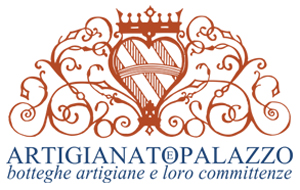Ars longa vita brevis: Hippocrates teaches us that life is short and art is long to learn.
Craftsmen know this, who all their lives learn, even when they have refined their art, even when they teach it to apprentices. Artisans know the value of time because their work cannot be separated from an immoderate, almost luxurious use of hours.
It is the eighteenth century that marks for the first time in human history the beginning of capitalist-style industrial activity, replacing guilds, family workshops, and laboratories. But the Enlightenment eighteenth century is also the time of the birth of Europe, which is expressed not only as an idea, but as an instrument of civilization and modernity. Indeed, the birth of the first factories makes use of technicians and artists chosen without regard to borders or nationalities. Marquis Carlo Ginori hired a Viennese, J. Anreiter, to begin experiments in making porcelain from Italian clay; German Franz Tieffen created the first large Milanese weaving mill to produce wools of the quality of Dutch and English ones.
Florence has remained the symbol of the arts. But we are no longer in the time of the Medici and the great patronage of patrons. The craftsman is a great and happy survivor. Time, his favorite tool, has been right with many among them. The age in which we live has neither time nor sufficient resources to afford the extraordinary perfections that only the craftsman can invent. When this disappears, it leaves no manuals or textbooks. Today, artisans are the smartest, most capable and imaginative of the creators of objects, and craftsmanship has occupied much of the territory that once belonged to art. What has been lost in quantity has been gained in quality. And the quality can be appreciated in the ARTIGIANATO E PALAZZO exhibition in the lemon houses of the Corsini garden: a rare opportunity to discover the evolution of many ancient arts, not disappeared, but rather projected towards the world and the future.
Antonio Zanardi Landi
Secretary General European University Institute
When in ’95 we decided to have a review of artisans in our garden on the Prato in Florence I had in my heart hoped for the possibility of repeating it every year, and I hoped that this effort would be really useful to the artisans and could give them that consensus and support so necessary for the maintenance of the workshops and laboratories.
I am proud today to see that their enthusiasm, their ideas, their advice have enabled us to organize this second edition and I am especially honored to be able to give the artisans my support in this way, presenting them in a magnificent setting as their tradition and culture deserve.
To the great leather craftsman Gucci, who is by our side again this year, we wanted to dedicate a special space, where we could show how artisans still play an irreplaceable role within the company.
I want to thank for their support Gerardo Mombelli, Alberto Clò, Vannino Chiti, Mario Primicerio, Guido Clemente, the Friends of the Museums Association, the Cultural Association Città Nascosta along with our irreplaceable electrician Ivo Santi.
Giorgiana Corsini
Faced with an appointment like the one that sees the splendid garden of Palazzo Corsini sul Prato as the protagonist of the 2nd edition of ARTIGIANATO E PALAZZO artisan workshops and their commissions, the Region of Tuscany could not really back down. It is no coincidence, in fact, that the idea of a review of the most important artisan workshops in Italy was born in Florence, capital of the most “artisan” region in Italy. Yes, because with its 106,000 businesses and almost 300,000 employees, with an annual turnover close to 15 trillion, Tuscany is undoubtedly the region where the artisan product has the greatest impact on the overall regional gross domestic product. The regional government’s attentions to this backbone sector of our economy have, over the years, multiplied. In agreement with the category’s organizations, the region has launched numerous measures to support artisan enterprises. These include a specific tool for financing businesses, the “Artgiancredit.” An ad hoc measure was launched for the protection of quality artistic products, one of the priorities in the regional policy for crafts. Defending and publicizing traditional workshops means helping to avoid dispersing a cultural heritage of inestimable value. This edition of Crafts and Palace could not be more in tune with these goals. But another of the merits of the initiative is to highlight the historical and social value of crafts. What would our historic centers be without the presence of craft stores? And what would craft workshops be without the history and special relationships woven over time with the patrons of our towns? Precisely in order to encourage the presence of traditional crafts within historic centers, the region is planning a series of initiatives, some of which also leverage the urban planning tool. All without neglecting the needs, which the event has the merit of highlighting, for the modernization of the sector, particularly on the fronts of professional training, services and promotion.
Michele Ventura
Councillor for Productive Activities of the Region of Tuscany
For the 2nd edition of ARTIGIANATO E PALAZZO.
The I edition of ARTIGIANATO E PALAZZO brought together, in the splendid Garden of Palazzo Corsini sul Prato in Florence, in June 1995, as many as 57 of the most extraordinary and capable Italian artisans and ended with great success with the public and the press, attracting in the two days of the exhibition alone more than 5,000 visitors from all over Italy. In addition to the important cultural and popular contribution in itself, the Exhibition stimulated a moment of in-depth study on the “minor arts,” with the intention of bringing them ever closer to our everyday life, thus breaking away from the traditional canons of other Exhibitions-Market.
Also for this II edition, we start from the idea that in the handmade, creation never has an end and each work is never the same as another. And just talking about “handmade” (from the Latin “ex manu facere”: to make with the hands), the exhibitors of ARTIGIANATO E PALAZZO are once again loudly called upon to demonstrate live the various working techniques in which they excel.
The ARTIGIANATO E PALAZZO Exhibition was mainly born from the idea of reevaluating and reframing the figure of the craftsman and his work in the present day, considering it to be a high expression of quality and technique, linked yes to the client, but insisting on the idea of a craftsmanship that is “modern” in its nature, without with that forgetting the fundamental element of tradition. There was also a desire to emphasize the strong social relevance of the craftsman of yesteryear whose workshop often thrived around the palace, understood as a “showcase” and a place of experimentation, in the continuous exchange with patrons of all stripes.
Dutiful thanks go to Alessandro Grassi and Deborah Cioppi who took care of the Press Office with passion, to the ladies of the Administration Cesarina Bigalli, Manola Chemeri, Fiorella Fanfani and Elmira Gorini who with Giuseppe, Maurizio and Romeo followed us with kindness and patience, and to Sandra Castelletti and Alessandro Nesti for their help in organizing the layout.
Neri Torrigiani and Olivella Pianetti della Stufa
Leather, hide and bamboo in Gucci’s craft tradition
In one of the evocative Limonaie (lemon houses) in the Garden of Palazzo Corsini sul Prato, the venue for the 2nd edition of the ARTIGIANATO E PALAZZO exhibition, we have been invited to show how, within a great company like Gucci, artisan tradition and “modernity” still coexist.
Exclusively for visitors to the exhibition, therefore, a real workshop will be reconstructed, inside which Gucci’s skilled Florentine artisans, will make “live” for the first time the legendary Bamboo bag, visualizing all the stages of its production.
It will thus be possible to admire the peculiarity of the special treatments of the leather and the expertise in the manual cutting, the matching of the skins and the final realization of the product, as well as the treatment and folding of the Bamboo which, after a very special process of drying and lacquering, is transformed into the characteristic handle.
Gucci, which for the second time has chosen to support this original initiative, wants to emphasize that it knows how to masterfully combine handcrafted quality with a modern style by emphasizing the indispensable work of master artisans, while also reconfirming those characteristics of quality and originality that have made Italian craftsmanship famous and appreciated worldwide.
Domenico De Sole
President and Chief Executive Officer of Gucci


